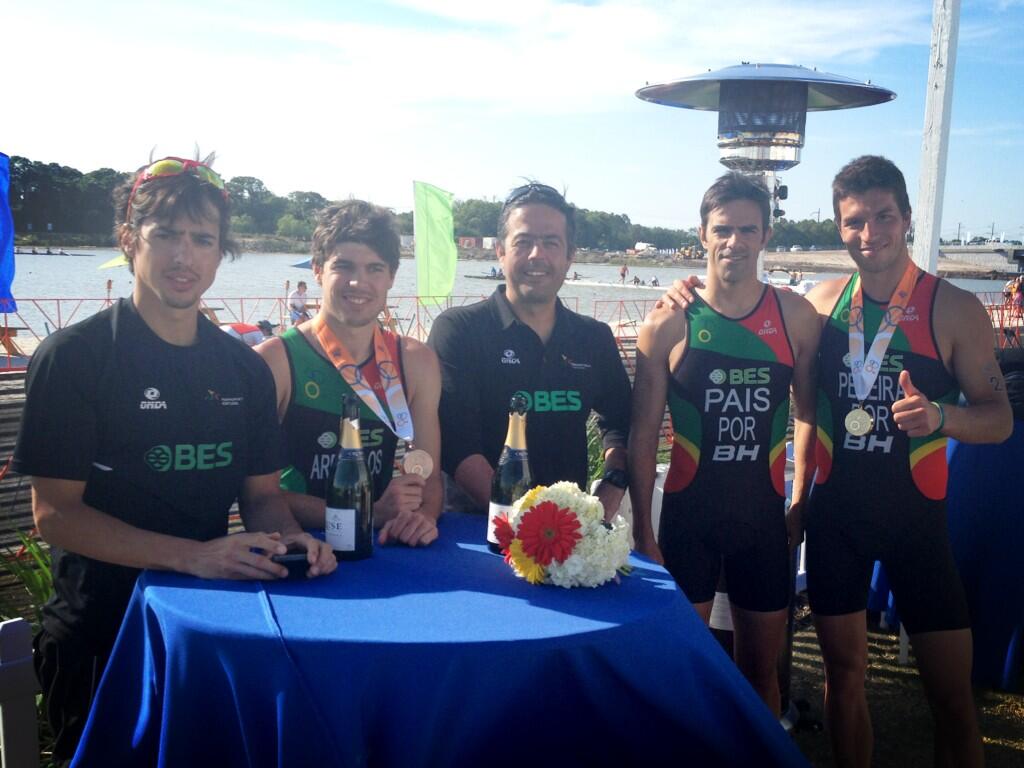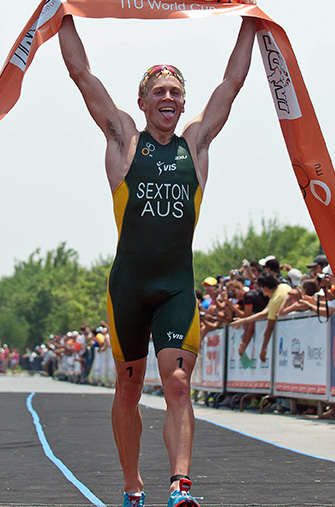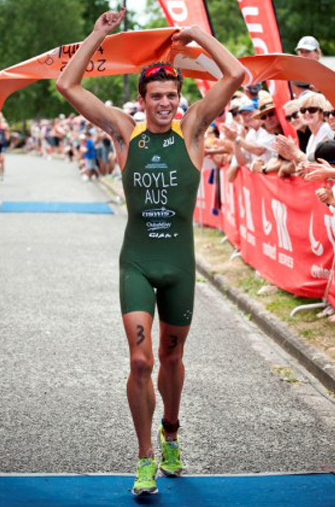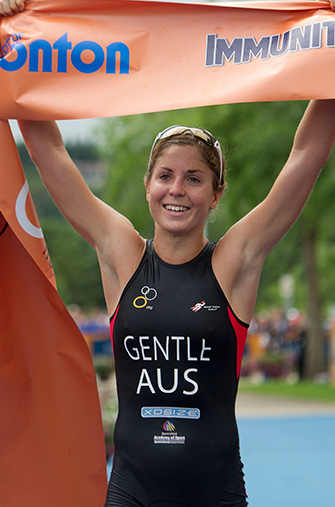Emma Snowsill – Recharging the engine
Phil Wrochna
From standing on top of the Beijing podium with a gold
medal around her neck, to being the unlucky woman who missed out on a
ticket to London, Emma Snowsill has seen it all. Firstoffthebike.com sat
down with ‘Snowy’ last week to find out how she is progressing in her
return to competition, and get some insight into where she sees women in
elite triathlon.
The dust has settled after the London Olympics. Where are you
now in terms of your racing and how was it standing there in London
taking a look at it?
Yeah as far as after London, like you said, the dust is settling. I
think the first decision, regardless of the outcome of London and
everything in the process that went on, is that I wanted to step away
from ITU racing and I wanted a break, or a change from that. So, that’s
definitely not on the cards. In terms of racing, it’s more the
non-drafting, Olympic-distance and try out [an Ironman] 70.3. But, to be
honest, first and foremost is getting back to being healthy enough to
put all those plans in motion.
I think over the last year, I’ve sort of got away with it a lot in a
sense. When you push your body and you’re always at the extreme on that
knife’s edge, I think your body at some point says enough and that’s
really where I found myself. It was a combination of a lot of the things
that have just compounded on top of having a pretty serious virus at
the end of the season, which meant I couldn’t be doing anything for a
couple of months
. I got a seriously severe
parasite, and on top of that, slowly my health couldn’t keep up with the
extra fighting. I think after not making the team it was a combination
of the stress I’d put myself through, but I just felt like I needed some
time out. My body saying enough was enough. I was constantly getting
colds where I knew it wasn’t normal and I just knew that my immune
system had really taken a battering and if I didn’t change and do
something about it then there was no way I would be able to continue the
way I was.
 Watching the Olympic games, how was that for you? How were
your interactions with some of the people, the TA people etc. while you
were at the races?
Watching the Olympic games, how was that for you? How were
your interactions with some of the people, the TA people etc. while you
were at the races?
Actually during the women’s race, I was back out towards the village
on top of a shopping centre building doing some Channel 10 work for all
the coverage back in Australia and I didn’t get time to get back to the
actual site. I watched it all on TV, and look, athletically it’s the
hardest thing that I’ve ever sort of put myself through. I think, even
now, it does affect your guts, you know get that feeling where you wish
you were there, you wish things were different and would’ve loved to
have been competing.
I thrive on competing for my country. I thrive on competing at the
top level. It’s different when you are in the ball game and you’re there
[competing] and if something happens then sobeit. But when you’re not
there, when you don’t have the chance, it’s really hard. It’s really
hard to come to terms with, but in the same breath, I had to look at
what I’ve had, the experience I had in Beijing and I had to take away
from the fact that, well, if I only got to go once then I made the most
of it. That’s all part of reasoning. I found another reason to be there
and to broaden my horizon in the sport. But I did manage to get out to
the men’s race and it’s an atmosphere and a feeling that I’m probably
glad I didn’t go out there for the women’s because it was incredible. I
mean, there’s no denying that being at an Olympics is just something
special. It’s a feeling which, like I said, probably was good. I did
enjoy it for a bit, but it was a feeling that I love. I loved being
there and the men’s race obviously was phenomenal to watch, but I think
going back to the whole Olympics and obviously not being a competitor
there and my experience shortly after the men’s race really reiterated
to me some of the biggest problems we have in terms of not just the fact
that I missed out, but the unanswered questions. In particular, why,
and the process in which it occurred, and I think that was probably what
was actually more saddening for me.
You know, frustration obviously comes into it, but I think my thought
process from there on in was this just shouldn’t happen this way.
Athletes do well with clear cut. You know, they can reason with
themselves if it’s something like a mechanical issue or something that
they didn’t do on the day. I think for me that was something that I felt
really upset by. The more questions I seemed to ask, the more greyer it
seemed to get and there’s obviously many, many people involved in not
only the process of high performance and selecting a team, but within
our sport, and I think if you’re dealing with elite athletes you really
need to know how to deal with them. And I understand, there’s plenty of
people in those jobs that are very good at what they do, and they run an
organisation, which is something I’m not interested in doing and have
no idea about. But if they want to feel a part of an elite athlete
reaching for the pinnacle of their sport, I just really think they’ve
got to be more involved if they choose to be in that process. You know,
obviously age group [racing] is what makes our sport, but at the other
end of the spectrum, you also need to have an understanding of when it
comes to Olympic selection, the [Olympic] processes and how best to deal
with athletes and where they’ve come from, what they’ve done, sometimes
it can come across as maybe not all that diplomatic.
Would you be happy with a one or two race selection criteria
where basically you are given two dates to show up to and if you do your
best and get the results you go straight into an Olympic team? Would
you be onboard with that, yes or no?
Yes, definitely. It’s something that, as athletes, racing is
pressure. When you want to perform you put a pressure on yourself and
given Olympic selection, sure that’s another pressure, but to race in an
Olympics is another pressure again. If you’re not able and prepared to
handle that pressure, then it’s something you need to look at to work
upon and I think, like I said, it gives you reasoning as an athlete.
If you stuff up on the day, you walk away and you go, you know what, I
didn’t get it right. Sure, you’re going to beat yourself up for a bit.
You’re going to be upset and feel all the normal things, but you walk
away and say, well, it was down to me, and you can change that. When
it’s not, it’s just more questions, it’s more grey. I don’t really see
how any other young and up-and-coming athlete looks at it and doesn’t
say, “what do I really have to do?” It’s all about setting goals and
putting the process in place, that’s what athletes work off, and, like I
said, everybody takes a step back, everybody learns. Unfortunately, at
times, there are probably more lows than highs in that respect, but you
get to understand that about yourself and how you work through that, and
as an athlete, you can walk away from that a lot, lot better than these
constant grey areas.
 Moving away from the Olympic and the selection criteria,
etc., I want to talk to you about the business of triathlon because
you’re someone who has been at the top end. You’ve done the TV
commercials; you’ve been on billboards; you’ve been a poster girl for
both your sport and for your sponsors. First, in your experience, how
tough, as a woman, is it to go and get yourself sponsored to a point
where you are full-time and you make a living out of it?
Moving away from the Olympic and the selection criteria,
etc., I want to talk to you about the business of triathlon because
you’re someone who has been at the top end. You’ve done the TV
commercials; you’ve been on billboards; you’ve been a poster girl for
both your sport and for your sponsors. First, in your experience, how
tough, as a woman, is it to go and get yourself sponsored to a point
where you are full-time and you make a living out of it?
I think there are two aspects in my experience. [The first] is one
that you’re dealing with Australia in an Olympic sport, which when you
get to be involved [with an Olympics] you are privy to seeing other
Olympians and what differentiates them in terms of sponsorship – and
every sport’s different. I think we’re far better off than I would say
what rowers get. But in terms of swimmers, who can win, what, five gold
medals, you constantly look at where value is and what value is and I
think in terms of a whole, I think I’ve been very fortunate to receive
what I have. And to be able to also promote the sport, to say look out,
our sport is up there.
Our sport is just as big and as great as any other of the Olympic
sports, but in terms of within the sport, I think the same. Honestly, it
is. It’s a huge market in terms of what exposure you can get, what
branding you can get within the sport itself, but I think it’s always
going to be a hard one counteracting against males because I honestly I
don’t look to compare. I can’t really worry about it because
unfortunately I’m worried about my results and I think I’ve always been a
fairly big believer in, if I do well and I promote my results, then
hopefully then people will continue to support me and in return then I
try and work with them as best as I can.
I honestly don’t have a direct correlation between what the top man
earns and what the top woman earns because I’m not going to sit and
worry about it. I do the sport for what it is and it’s why I love it. I
love supporting the people who support me and I’m very thankful for
whatever I get from them. I know it has to be different to some degree,
I’m sure, but I also believe that it’s totally market-based in the
country we live in.
I think being an Australian competing in the US I found a lot of
support there. I was actually surprised with how welcoming they were of a
foreign athlete and how much they embraced and wanted to take me
onboard. I think you have to promote yourself as being a good
sportsperson, but being yourself also helps in terms of sponsorship as
well. You obviously can’t deliver the world in a sense that you can be
here, there and everywhere for them because they want results as well.
There are a few markets, I guess, I always look at in terms of how do I
see myself, and I think that constantly adjusts and readjusts too,
particularly during the time I’ve been in the sport.
 For young women who want to turn professional, given the
amount of men in triathlon, do you think that’s a turn off or do you
think people will overcome and do what they love?
For young women who want to turn professional, given the
amount of men in triathlon, do you think that’s a turn off or do you
think people will overcome and do what they love?
Well, absolutely not. I see the opportunities for young girls and
sponsorship at the ages that are probably younger than when I was in
even involved in the sport. I think it’s incredible. I think the support
is amazing. I think it’s there for the taking. In some respect, I think
the younger guys are up against tougher competition. Unfortunately
that’s the nature of any sport. The quality of men, I guess, in a
smaller pool is it’s always going to be greater. It’s human nature. It’s
the way [our] bodies are built, and I think for the girls, there are so
many more women-specific, not just products, but also in terms of
women-specific campaigns and advertising for bikes. The fact that bikes
are now being designed for women. That’s something where women can
corner part of the market and utilise it for their own benefit in
racing, and also for their own return in sponsorship. I definitely don’t
see that it’s harder by any means.
So where do you see the direction of women in triathlon? Do
you think it’s in good shape or does it need more stronger characters
like yourself or Chrissie Wellington, who was always so vocal with
everything she did and at every race she went to? Where’s the direction
for you overall and I guess even more specifically the ITU world given
that that’s where you’ve just recently come from?
I probably can’t talk so much on an international level, I know more
from my experience on an Australian level. It’s a tricky one. I was
thinking about it the other day. I really feel like I’ve almost been in
three generations of my sport in the sense that I’ve really came out of
an amazing era of women’s triathlon in Australia with Michellie Jones,
Loretta Harrop and Nikki Hacket. Trying to make an Australian worlds
team of six girls was ridiculous, like it was a catfight. Looking where
we are now, sometimes I think, well, what’s happening? Not what’s gone
wrong but what’s not happening.
Personally, I don’t know very many of the junior girls. I don’t
really know a lot of our young up-and-comers other than the girls like
the Ashleigh Gentle and the Emma Jackson, who have come onto the ITU
scene. For me, when I really look back to where I was at that age, the
biggest gap I see is how do the younger girls learn when they’ve got
no-one else there around them to look up to. I mean that in a sense of,
there are not really any opportunities where they get to be around and
train [with older athletes], and I think the best way to learn is to
observe and to be in an environment where the best of the best are there
and you are trying to emulate them.
I remember by first ever World Cup and my coach at the time, Bill
Davoren, said this is Michellie Jones. You follow her, you shadow her,
you watch everything she does in this race and, of course, I was like:
Oh my God, no, that’s so scary,
that’s just ooh, ooh, ooh.
I think those are the points where young athletes; they need to see
what they’re doing. They need to see what it takes. They need to see
what’s involved in being the best. I think that probably is one small
area that could really be improved with the up-and-coming generation in
our sport in Australia, and for females obviously. It’s a tricky one. It
is tricky because the type of racing has changed as well in the respect
that we have under-23 races and there are big jumps to be made. But I
honestly feel that if I wasn’t given the opportunities and experiences
to be able to train with Loretta Harrop, Siri Lindley, Lizbeth
Kristensen, Annie Emmerson, Bella Comerford and people that were at the
top of their game… I was just chasing, chasing, chasing all the time,
and I think that was great for me. I think that showed me hunger.
Learning and watching what they did and how they prepared in training
for races and watching how they raced. I think that was just an
invaluable experience that you can’t necessarily just teach.
To the young women who are coming into triathlon not just age
groupers, but elites, who are looking to make a living out of it, if
you could give them one piece of advice from all of what you know, what
would it be?
It’s interesting because I was always of the belief that if you work
hard, the results will come, and if the results come the sponsorship
will come. I really believe that comes hand-in-hand and I think it’s one
thing to work on sponsorship, but you also need to be able to show your
credentials as well. So it’s one thing to be out there and marketing
yourself, but you can’t let that detract from training, and I think as
you progress and you get more results, that’s when you start looking at
how do I balance what I now have and how do I improve myself with
sponsorship and in the market of triathlon as a female athlete.
Realistically, I would look at it and go: work out what your dreams and
goals are within the sport and chase after them first because everything
else will follow.

















 Race Date: March 16, 2013
Race Date: March 16, 2013










